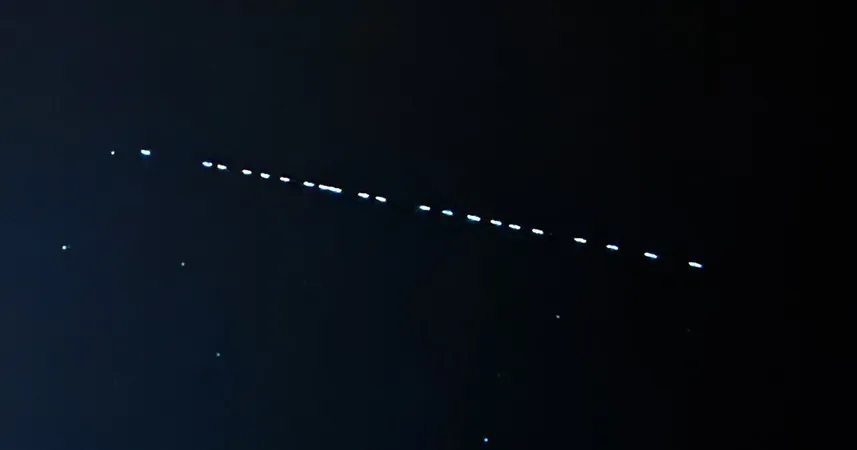
Astronomers Demand Halt on SpaceX's Starlink Launches Amid Environmental Concerns
2024-11-07
Author: Mei
Astronomers Demand Halt on SpaceX's Starlink Launches Amid Environmental Concerns
A coalition of over a hundred astronomers has issued a clarion call for the United States Federal Communications Commission (FCC) to impose a moratorium on launches of SpaceX’s Starlink and similar mega-constellation satellite projects. Their primary concern centers on the ecological implications of sending tens of thousands of satellites into orbit and the adverse effects on ground-based observatories tasked with studying the cosmos.
The astronomers stress the need for a thorough investigation into the environmental consequences of deploying these satellites before any further launches take place. They criticize the FCC for its decision to exempt mega-constellations from undergoing necessary environmental assessments, advocating for a regulatory framework that includes these expansive satellite networks.
Robert McMillan, an astronomer at the University of Arizona and one of the signatories of the open letter, expressed the potential ramifications, stating, “Artificial satellites, even those invisible to the naked eye, can hinder astronomical observations responsible for detecting asteroids and enriching our understanding of the universe.” He further highlighted that “the potentially long-term environmental harms of deploying tens of thousands of satellites are still unclear,” underscoring the urgency of the matter.
Currently, there are over 9,000 active satellites orbiting Earth, with SpaceX's Starlink program representing a dominant portion, boasting approximately 6,500 functioning satellites since its initial launch in 2019. This acceleration is staggering; throughout the entirety of human spaceflight history, roughly 19,500 satellites have been launched, according to the European Space Agency.
This rapid deployment has led to significant frustrations within the astronomical community, as they claim the brightness of these satellite constellations severely disrupts their observations of the night sky. Moreover, emerging research indicates that radiation emitted by the onboard electronics of these satellites is interfering with radio telescopes, potentially undermining our ability to explore the furthest reaches of space.
The environmental implications are not merely theoretical. The increasing volume of space debris in low Earth orbit was already a pressing concern prior to the surge of mega-constellations, an issue that has only worsened. There are real worries that these short-lived satellites, designed for limited operational lifespans, could wreak havoc on our planet as they re-enter the atmosphere, risking pollution and posing a danger to both spacecraft and human life.
The Federal Aviation Administration has even issued warnings that malfunctioning satellites re-entering could pose lethal risks to individuals on the ground. Experts believe we may be underestimating the number of surviving fragments making their way back down, as many components intended to disintegrate during re-entry are instead crashing onto Earth's surface.
Lucas Gutterman, who led the initiative and is the director of the nonprofit Public Interest Research Group, highlighted the disconnect between the fast-paced space industry and the regulatory framework, saying, “The space industry has moved faster than the public or regulators were able to keep pace with. The urgency of this issue warrants discussion in homes, not just among industry insiders.”
As this debate heats up, it is clear that the ramifications of our burgeoning satellite infrastructure extend far beyond the stars. The experts assert that serious considerations surrounding the balance between technological advancement and environmental stewardship are essential in guiding the future of our use of space.
Stay tuned for updates as this story evolves, and discover the potential technological breakthroughs that may reshape our understanding of the universe!

 Brasil (PT)
Brasil (PT)
 Canada (EN)
Canada (EN)
 Chile (ES)
Chile (ES)
 España (ES)
España (ES)
 France (FR)
France (FR)
 Hong Kong (EN)
Hong Kong (EN)
 Italia (IT)
Italia (IT)
 日本 (JA)
日本 (JA)
 Magyarország (HU)
Magyarország (HU)
 Norge (NO)
Norge (NO)
 Polska (PL)
Polska (PL)
 Schweiz (DE)
Schweiz (DE)
 Singapore (EN)
Singapore (EN)
 Sverige (SV)
Sverige (SV)
 Suomi (FI)
Suomi (FI)
 Türkiye (TR)
Türkiye (TR)